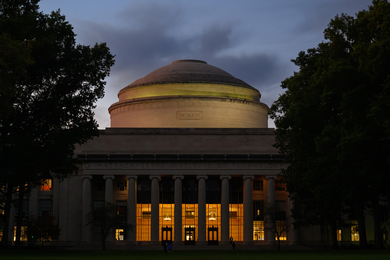CAMBRIDGE, Mass. -- William Hewlett, co-founder of Hewlett Packard, has donated $5 million to MIT to endow a discretionary fund supporting leadership initiatives of the Institute president. MIT President Charles M. Vest today announced the establishment of the William R. Hewlett Presidential Leadership Fund.
The Hewlett fund draws its inspiration from Mr. Hewlett's 1986 MIT commencement speech, said his son Walter, a co-trustee of the William R. Hewlett Trust, which is underwriting the endowment. That speech commemorated the 50th anniversary of William Hewlett's graduation from MIT with the master's degree in electrical engineering. In talking to the graduating students, William Hewlett emphasized the importance to a high-tech society of innovation and creativity. The best way to find creative people, he said, was by "establishing an environment that fosters creativity and observing who flourishes."
Creating that kind of environment at colleges or universities is the special responsibility of their leaders, said Walter Hewlett. However, heads of nonprofit institutions rarely have sufficient discretionary resources to support important programs or new directions. The new Hewlett Presidential Leadership Fund will help the president of MIT identify and meet "really critical needs," he said, which might otherwise go unfunded.
Although MIT presidents have traditionally had some discretionary funds at their disposal, the William R. Hewlett President Leadership Fund is the first to be endowed and the first to specifically support leadership initiatives in the President's Office.
In accepting the endowment, President Vest said, "Bill Hewlett is a great American citizen whose accomplishments as a technologist and business leader are almost are almost unparalleled. It is an honor for MIT to be recognized by him in this manner. We are proud to have his name associated with MIT."
Mr. Hewlett, now 86, began his legendary company in 1939 in a Palo Alto garage with a friend from his days at Stanford University - the late David Packard. In addition to his MIT degree, Mr. Hewlett holds Stanford bachelor of arts and engineering degrees. The first product of the company was a resistance-capacitance audio oscillator based on a design Mr. Hewlett developed when he was in graduate school. The audio oscillators helped make Walt Disney's "Fantasia" (1940) possible.
Now an HP director emeritus, Mr. Hewlett was actively involved in the company from 1939 until 1987, except during World War II when he was an Army officer. He was successively vice president, executive vice president, president and chief executive officer (to 1983 when he became vice chair of the board of directors). He and Mr. Packard built the company into an international manufacturer of measurement and computation products and systems used in industry, business, engineering, medicine and education.
Mr. Hewlett has long had a keen interest in education and medicine, serving as a trustee of Mills College in Oakland, Calif., and of Stanford University. He was board president, then a director of the Palo Alto-Stanford Hospital Center (now Stanford Medical Center), a director of the Kaiser Foundation Hospital and Health Plan and the Drug Abuse Council in Washington, DC. He holds 13 honorary degrees from U.S. colleges and universities and one from the University of Bologna in Italy.
His philanthropic activities have been conducted primarily through the William and Flora Hewlett Foundation, which he established with his late wife in 1966. In 1995, Mr. Hewlett supported the founding of the Public Policy Institute of California with an endowment of $70 million.
Mr. Hewlett has a wide range of interests and hobbies, most of them based on his love of the outdoors. He is a part-time botanist and an accomplished mountain climber, skier and fisherman.
From its publication in 1996, "The HP Way, How Bill Hewlett and I Built Our Company," by the late David Packard has been on best-seller lists of business books. It describes HP's widely admired system of "management by wandering around" and other strategies for improving quality, lowering costs and expanding markets.





